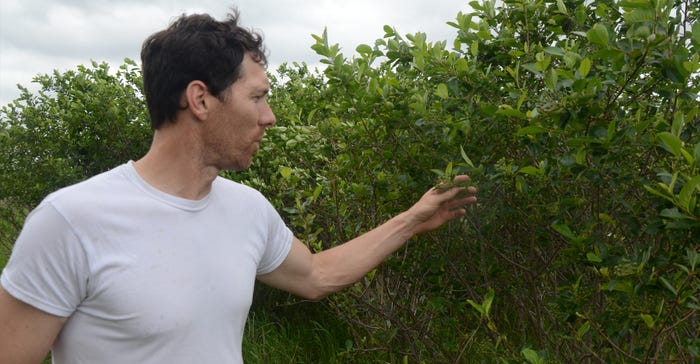
Before he came back to the family farm in Washington County, Iowa, Levi Lyle hadn't even heard of pawpaws or honeyberries. Now, he dedicates about 4 acres to pawpaws, honeyberries, aronia berries, persimmon, dwarf tart cherries and black currant, all of which are acclimated to the hot summers and cold winters that come with a continental climate.
"I knew for a while I wanted to come back to the farm, but didn't know when the right time was," says Lyle, 42. "I knew waiting until my dad was older or not in good health would make it a much steeper learning curve. He was able to help me in terms of knowledge and financially."
Lyle came back to the farm about 10 years ago. To help him get started, his dad, Trent, allowed him to grow fruit on a less productive corner of a field.
"The biggest hurdles to young farmers include startup costs and access to land," Lyle says. "In addition, a lot of farmers still have off-the-farm income. My off-the-farm jobs for the last 10 years were schoolteaching, social services and coaching."
During his first few years on the farm, Lyle was working as an inspector for organic certification and used the opportunity to learn from growers he worked with. He also relied on resources like the Native Fruit Association and the American Aronia Berry Association, as well as Iowa State University Extension horticulture specialists like Patrick O'Malley in Johnson County.
"The diversification of farm enterprises was really an awakening," Lyle says. "When I decided to come back to the farm, I knew I wanted to diversify and do something more than traditional corn and soybeans, but I didn't know exactly what I was going to do. I asked, 'What will ripen in the summer months when I'm not as busy?'"
So, in June he harvests honeyberries, followed by black currant and several varieties of dwarf tart cherries in July. Aronia berries are harvested in August, and pawpaws are harvested later in October — after corn and soybeans. Most of these fruits can be harvested using the same equipment.
"All that is happening while I don't have to be in the field with corn and soybeans," he says. "There's synergy in staggering harvest, processing and refrigerating of these berry crops — and it happens at the time of year when corn and soybeans are relatively hands-off."
Different marketing strategies
He established his own aronia berry processing facility in his family's farm shop, processing 200,000 pounds of aronia berries from farms across southeast Iowa before the disruption caused by COVID-19. Through a collaboration with another local organic processor, Kalona Supernatural and ARTI Trucking, he delivers aronia berries to 15 stores in Minneapolis, in addition to the grocery stores he markets to locally.
"At first, we sold all of our aronia at farmers markets, but being able to put it on a truck and have it end up in 15 stores in Minneapolis is why I've stayed in the game," he says. "The processing facility helped complete the circle. To grow berries and get them to a food buyer is a gap that needs to be filled. You need processors and cold storage."
Growing different fruits that ripen at different times in the summer allows him to spread out his marketing. Lyle typically markets the rest of his produce to local restaurants, but he's recently opened up his orchards as U-pick sites for customers to come to the farm and pick the fruit.
"With aronia berries, we know we have an established market in grocery stores, and that can draw attention to the farm, and that helps draw people for a U-pick," he says. "Farm-gate sales seem to work best for me for the rest of the produce. I wanted to prioritize my family, and that's moved me toward farm-gate sales, rather than traveling around, visiting stores on a weekly basis."
Outside revenue streams
Two years ago, Lyle purchased a Weed Zapper built by Old School Manufacturing in Sedalia, Mo. The Weed Zapper uses a PTO generator to charge a copper bar on the implement with high-voltage electricity. A circuit is completed when the copper bar above the canopy makes contact with weeds, killing them instantly, boiling the cells of the plant all the way to the root zone. It's typically used in organic soybean fields around midseason, when weeds grow above the canopy. For the last two years, Lyle has used his Weed Zapper for custom work on local organic farms.
"I needed to do custom work, because I don't have the acres to justify that equipment just on my own farm. Running it on other people's farms the last couple years helped me purchase that machine," he says.
Lyle has also diversified his revenue by leasing out roller-crimpers he owns in different parts of Iowa, northern Missouri and eastern Nebraska.
"I lease out the roller-crimpers I own to about 10 people in a given year," he says. "Now I'm able to supplement income through U-pick, custom weed zapping and leasing out my roller-crimpers. I don't need to work off the farm, and I'm independently employed, thanks to the diversification of my farm enterprises."
About the Author(s)
You May Also Like






